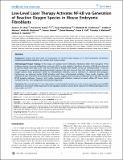| dc.contributor.author | Chen, Aaron Chih-Hao | |
| dc.contributor.author | Arany, Praveen R. | |
| dc.contributor.author | Huang, Ying-Ying | |
| dc.contributor.author | Tomkinson, Elizabeth M. | |
| dc.contributor.author | Sharma, Sulbha K. | |
| dc.contributor.author | Kharkwal, Gitika B. | |
| dc.contributor.author | Saleem, Taimur | |
| dc.contributor.author | Mooney, David J. | |
| dc.contributor.author | Yull, Fiona E. | |
| dc.contributor.author | Blackwell, Timothy S. | |
| dc.contributor.author | Hamblin, Michael R. | |
| dc.date.accessioned | 2011-10-03T17:34:16Z | |
| dc.date.available | 2011-10-03T17:34:16Z | |
| dc.date.issued | 2011-07 | |
| dc.date.submitted | 2011-02 | |
| dc.identifier.issn | 1932-6203 | |
| dc.identifier.uri | http://hdl.handle.net/1721.1/66163 | |
| dc.description.abstract | Background
Despite over forty years of investigation on low-level light therapy (LLLT), the fundamental mechanisms underlying photobiomodulation at a cellular level remain unclear.
Methodology/Principal Findings
In this study, we isolated murine embryonic fibroblasts (MEF) from transgenic NF-kB luciferase reporter mice and studied their response to 810 nm laser radiation. Significant activation of NF-kB was observed at fluences higher than 0.003 J/cm2 and was confirmed by Western blot analysis. NF-kB was activated earlier (1 hour) by LLLT compared to conventional lipopolysaccharide treatment. We also observed that LLLT induced intracellular reactive oxygen species (ROS) production similar to mitochondrial inhibitors, such as antimycin A, rotenone and paraquat. Furthermore, we observed similar NF-kB activation with these mitochondrial inhibitors. These results, together with inhibition of laser induced NF-kB activation by antioxidants, suggests that ROS play an important role in the laser induced NF-kB signaling pathways. However, LLLT, unlike mitochondrial inhibitors, induced increased cellular ATP levels, which indicates that LLLT also upregulates mitochondrial respiration.
Conclusion
We conclude that LLLT not only enhances mitochondrial respiration, but also activates the redox-sensitive NFkB signaling via generation of ROS. Expression of anti-apoptosis and pro-survival genes responsive to NFkB could explain many clinical effects of LLLT. | en_US |
| dc.description.sponsorship | National Institutes of Health (U.S.) (grant R01AI050875) | en_US |
| dc.description.sponsorship | Center for Integration of Medicine and Innovative Technology (DAMD17-02-2-0006) | en_US |
| dc.description.sponsorship | United States. Dept. of Defense (CDMRP Program in TBI, W81XWH-09-1-0514) | en_US |
| dc.description.sponsorship | United States. Air Force Office of Scientific Research (FA9950-04-1-0079) | en_US |
| dc.language.iso | en_US | |
| dc.publisher | Public Library of Science | en_US |
| dc.relation.isversionof | http://dx.doi.org/10.1371/journal.pone.0022453 | en_US |
| dc.rights | Creative Commons Attribution | en_US |
| dc.rights.uri | http://creativecommons.org/licenses/by/2.5/ | en_US |
| dc.source | PLoS | en_US |
| dc.title | Low-Level Laser Therapy Activates NF-kB via Generation of Reactive Oxygen Species in Mouse Embryonic Fibroblasts | en_US |
| dc.type | Article | en_US |
| dc.identifier.citation | Chen, Aaron C-H. et al. “Low-Level Laser Therapy Activates NF-kB via Generation of Reactive Oxygen Species in Mouse Embryonic Fibroblasts.” Ed. Wafik S. El-Deiry. PLoS ONE 6 (2011): e22453. | en_US |
| dc.contributor.department | Harvard University--MIT Division of Health Sciences and Technology | en_US |
| dc.contributor.approver | Hamblin, Michael R. | |
| dc.contributor.mitauthor | Hamblin, Michael R. | |
| dc.relation.journal | PLoS ONE | en_US |
| dc.eprint.version | Final published version | en_US |
| dc.type.uri | http://purl.org/eprint/type/JournalArticle | en_US |
| eprint.status | http://purl.org/eprint/status/PeerReviewed | en_US |
| dspace.orderedauthors | Chen, Aaron C-H.; Arany, Praveen R.; Huang, Ying-Ying; Tomkinson, Elizabeth M.; Sharma, Sulbha K.; Kharkwal, Gitika B.; Saleem, Taimur; Mooney, David; Yull, Fiona E.; Blackwell, Timothy S.; Hamblin, Michael R. | en |
| mit.license | PUBLISHER_CC | en_US |
| mit.metadata.status | Complete | |
